

Journalist | Writer
I'm a journalist, magazine editor and writer. Amsterdam-based but London and Switzerland-hailing. I write long-form narratives and feature about European topics, across culture, climate and people. Interested in underreported voices, forgotten histories and the things that make us feel something.

I've written for publications like VICE and Men's Health and brands like Booking.com and Catawiki. I specialise in long-form features and news pieces across culture, music, social issues and climate.
If you want to get more of a sense of my writing and what I do, my substack is a good place to begin:
https://iusedtotalk.substack.c...
I'm always open for commissions, whether that's for features, brand editorial, news and video or investigative.























